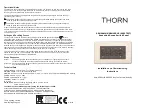
DXS-3600 Series 10GbE Layer 2/3 Switch Hardware Installation Guide
20
Managed devices that support SNMP include software (referred to as an agent), which runs locally on the device. A
defined set of variables (managed objects) is maintained by the SNMP agent and used to manage the device. These
objects are defined in a Management Information Base (MIB), which provides a standard presentation of the
information controlled by the on-board SNMP agent. SNMP defines both the format of the MIB specifications and the
protocol used to access this information over the network.
This switch supports SNMP Versions 1, 2c, and 3 alternatively known as
SNMPv1
,
SNMPv2c
and
SNMPv3
. The
administrator may specify which version of SNMP to use to monitor and control the switch. The three versions of
SNMP vary in the level of security provided between the management station and the network device.
In SNMPv1 and SNMPv2c, user authentication is accomplished using 'community strings', which function like
passwords. The remote user SNMP application and the Switch’s SNMP must use the same community string. SNMP
packets from any station that has not been authenticated are ignored (dropped).
The
default community strings
for the Switch used for SNMPv1 and SNMPv2c are:
•
public
- Allows authorized management stations to retrieve MIB objects.
•
private
- Allows authorized management stations to retrieve and modify MIB objects.
Figure 4-9 To view the SNMP community strings
SNMPv3 uses a more sophisticated authentication process that is separated into two parts.
1 The first part is to maintain a list of users and their attributes that are allowed to act as SNMP managers.
2 The second part describes what each user on that list can do as an SNMP manager.
The switch allows groups of users to be created and configured with a shared set of privileges. The SNMP version may
also be configured for a specific group of SNMP managers. A group of SNMP managers can be created to view read-
only information or to receive traps using SNMPv1 while assigning a higher level of security to another group, granting
read/write privileges using SNMPv3.
Using SNMPv3, individual users or groups of SNMP managers can be allowed to perform or be restricted from
performing specific SNMP management functions. The functions allowed or restricted are defined using the Object
Identifier (OID) associated with a specific MIB. An additional layer of security is available for SNMPv3 in which SNMP
messages may be encrypted.
Traps
Traps are messages that alert network personnel of events that occur on the switch. The events can be as serious as a
reboot (someone accidentally turned OFF the switch), or less serious like a port status change. The switch generates
NOTE:
For customers interested in D-View, D-Link Corporation's proprietary SNMP management
software, go to http://dview.dlink.com.tw/ and download the software and manual.
DXS-3600-32S#show snmp community
Community Name: private
Community Index: private
Community SecurityName: private
storage-type: nonVolatile active
Community Name: public
Community Index: public
Community SecurityName: public
storage-type: nonVolatile active
DXS-3600-32S#
Содержание DXS-3600-16S
Страница 1: ...Hardware Installation Guide Product Model DXS 3600 Series Layer 2 3 Managed 10GbE Switch Release 1 10 ...
Страница 35: ...DXS 3600 Series 10GbE Layer 2 3 Switch Hardware Installation Guide 29 Warranty ...
Страница 36: ...DXS 3600 Series 10GbE Layer 2 3 Switch Hardware Installation Guide 30 Technical Support ...











































